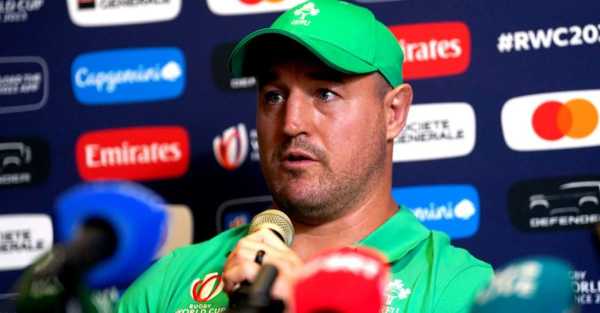
Veteran Ireland hooker Rob Herring never doubted his ability to play at a Rugby World Cup as he prepares to make up for past disappointments with an overdue tournament debut.
South Africa-born Herring has been selected to start Saturday’s Pool B opener against Romania ahead of the fit-again Ronan Kelleher and in the absence of the injured Dan Sheehan.
Advertisement
The 33-year-old was called up by Joe Schmidt in the build-up to the 2015 and 2019 competitions before being cut from the final squads.
He subsequently flew to Japan four years ago as an injury replacement for Sean Cronin but was not involved as Ireland crashed out in the quarter-finals to New Zealand and has since been eclipsed by the emergence of Leinster pair Sheehan and Kelleher.
“Yeah, it’s been a long run for me,” said Herring. “I was involved in the two previous World Cup pre-seasons and missed out on selection so I think all the work over the last year, it’s paid off to be here now.
Advertisement Advertisement
“I always believed I was good enough to be here. The selection calls were tight in the last World Cup.
“I’ve been heavily involved in the squad since the last World Cup and I’m really enjoying my time under Faz (Andy Farrell) and the leadership of the coaches.
“It has been a great four years, and I’m just raring to go now.
Advertisement
“There’s obviously a bit more hype around the World Cup and a bit more pressure on games but that’s what we’ve been building for. Personally, I think I’m in a good place.”
Herring, who qualifies for Ireland through a grandparent, made his international debut as a replacement flanker during the 2014 tour of Argentina.
He had won just eight caps when head coach Farrell succeeded Schmidt after the 2019 World Cup but started all five matches of the 2020 Guinness Six Nations following the retirement of Rory Best.
Advertisement

Despite remaining a squad regular, Herring, who is set for his 38th Test outing this weekend, has become more peripheral since the breakthrough of dynamic duo Kelleher and Sheehan.
“My mindset going into it is this is just the start,” said the Ulster player.
Advertisement
“It’s a massive honour to be selected for the squad but this is just the start of it. I want to put my best foot forward and contribute to the team as well as I can.
“I think if I nail my role and everyone else does theirs, we will put in a strong performance.”
Ireland will be led by Johnny Sexton in Bordeaux on his return from suspension and injury.
Herring believes fly-half Sexton is the type of captain team-mates “want to follow into battle”.
“Johnny is one of the most competitive guys I’ve ever played under,” he said.
“I think that’s his massive point of difference. He’s unbelievably driven, he drives the standards at training, off the pitch, everything.
“He’s got an incredible winning mindset so he’s the kind of guy you really want to follow into battle. You know he’s going to be right up there at his best and giving it his all. It’s been great having him back.”
Sourse: breakingnews.ie